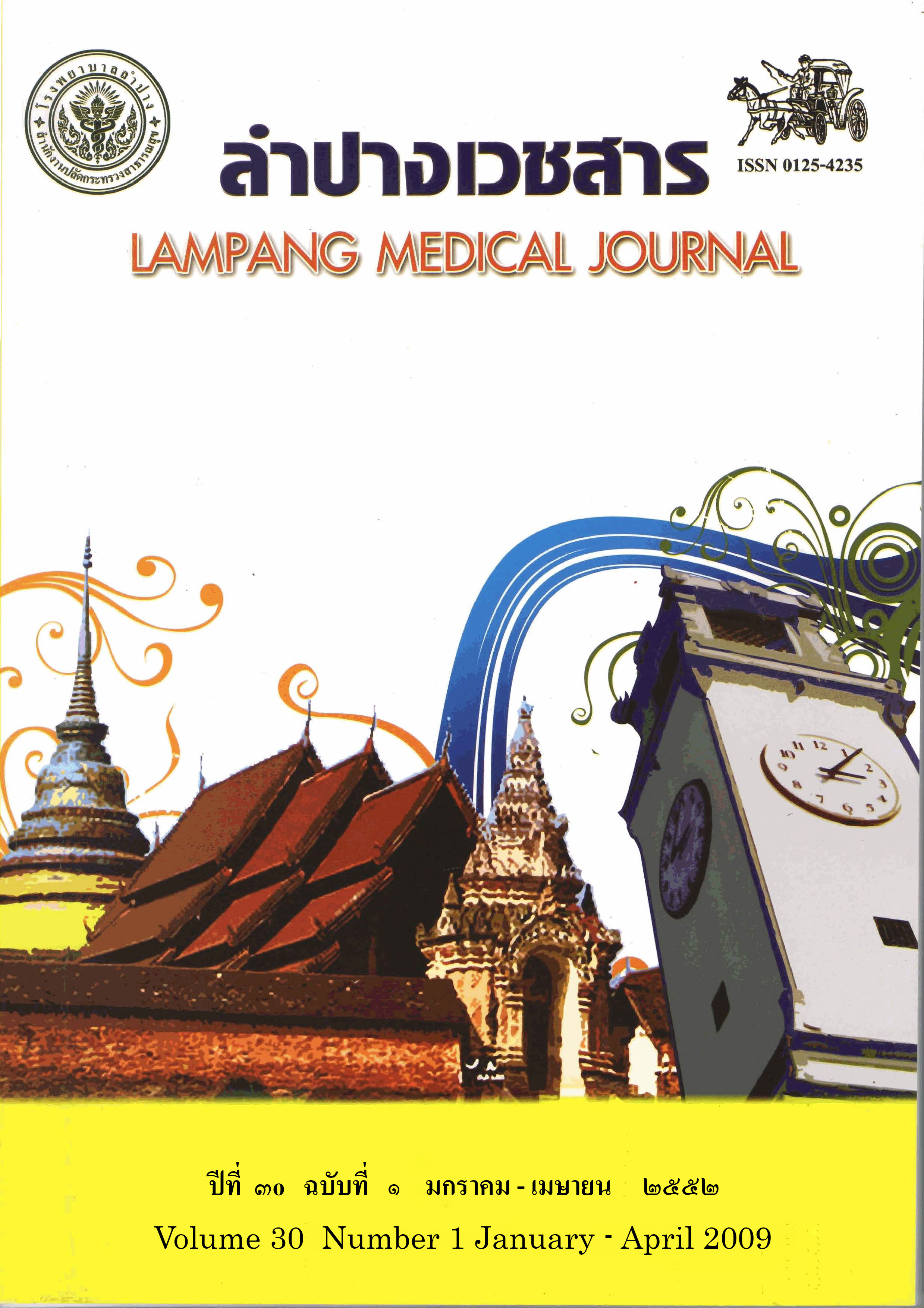Pulmonary Rehabilitation and Family Support Program to Improve Quality of Life among COPD Patients
Main Article Content
Abstract
Background: Chronic obstructive pulmonary disease (COPD) was important problem and leading cause of admission in Lampang Hospital. The COPD patients usually experience dyspnea, exacerbation and limitation of activities. Pulmonary rehabilitation is an intervention to improve the symptoms and quality of life.
Objective : To examine the effect of pulmonary rehabilitation and family support program for decreasing dyspnea symptom and improving quality of life among COPD patients.
Material and method : The quasi-experimental study, one group pre and post-test design, was conducted at COPD clinic of Lampang Hospital between September 2006 and May 2007. Thirty outpatients, 18 men and 12 women, aged between 54-79 years old. The severity of disease were level 3 and 4. The patients participated the pulmonary rehabilitation and family support program 4 times in 8 weeks. The dyspnea visual analogue scale (DVAS) and quality of life (QOL) index scores were assessed before and after the program. The data were analyzed by descriptive statistics and pair t-test. One year after finishing program, the number of hospital admission or emergency room attention were recorded and compared with the previous record.
Results : After finishing pulmonary rehabilitation and family support program, the DVAS and QOL index score were significantly improved (p=0.001). One year following program, 76.67% of the patients lessened frequency of emergency room attention and 46.67% minimized the hospitalization due to severe exacerbation comparing with the previous period before starting the program.
Conclusion : The author’s pulmonary rehabilitation and family support program could significantly improve dyspnea symptom and QOL in high-severity COPD patients. This program should be implemented and followed continuously to maintain its results.
Article Details

This work is licensed under a Creative Commons Attribution-NonCommercial-NoDerivatives 4.0 International License.
บทความที่ส่งมาลงพิมพ์ต้องไม่เคยพิมพ์หรือกำลังได้รับการพิจารณาตีพิมพ์ในวารสารอื่น เนื้อหาในบทความต้องเป็นผลงานของผู้นิพนธ์เอง ไม่ได้ลอกเลียนหรือตัดทอนจากบทความอื่น โดยไม่ได้รับอนุญาตหรือไม่ได้อ้างอิงอย่างเหมาะสม การแก้ไขหรือให้ข้อมูลเพิ่มเติมแก่กองบรรณาธิการ จะต้องเสร็จสิ้นเป็นที่เรียบร้อยก่อนจะได้รับพิจารณาตีพิมพ์ และบทความที่ตีพิมพ์แล้วเป็นสมบัติ ของลำปางเวชสาร
References
จันทร์เพ็ญ ชูประภาวรรณ. สถานะสุขภาพคนไทย. กรุงเทพฯ: อุษาการพิมพ์; 2543. หน้า. 252-60.
ศูนย์ข้อมูลสารสนเทศ โรงพยาบาลลำปาง. สถิติโรคปอดอุดกั้นเรื้อรัง; 2547.
สมาคมอรุเวชช์แห่งประเทศไทย. แนวทางการวินิจฉัยและการรักษาโรคปอดอุดตันเรื้อรังในประเทศไทย. กรุงเทพฯ: เรือนแก้วการพิมพ์; 2539. หน้า. 5-16.
American Association of Cardiovascular and Pulmonary Rehabilitation (AACVPR). Guidelines for pulmonary rehabilitation 2nd ed. Champaign:Human Kinetics; 1998.
American Thoracic Society (ATS). Pulmonary rehabilitation. Am J Respir Crit Care Med 1999;159:1666-82.
กมลวรรณ จันตระกูล. ผลของการฟื้นฟูสมรรถภาพปอดร่วมกับการสนับสนุนของครอบครัวต่อคุณภาพชีวิตผู้ที่เป็นโรคปอดอุดกั้นเรื้อรัง. [วิทยานิพนธ์พยาบาลศาสตรมหาบัณฑิต]. สาขาวิชาการพยาบาลผู้ใหญ่, บัณฑิตวิทยาลัย, เชียงใหม่ : มหาวิทยาลัยเชียงใหม่; 2547.
ธิดารัตน์ เกตุสุริยา. แบบการดำเนินชีวิตที่ส่งเสริมสุขภาพและการสนับสนุนทางสังคมของผู้ป่วยโรคปอดอุดกั้นเรื้อรังที่เข้ารับการรักษาซ้ำในแผนกอายุรกรรม โรงพยาบาลลำปาง [การค้นคว้าแบบอิสระพยาบาลศาสตรมหาบัณฑิต]. สาขาวิชาการพยาบาลผู้ใหญ่, บัณฑิตวิทยาลัย, เชียงใหม่ : มหาวิทยาลัยเชียงใหม่; 2547.
Cobb S. Social support as a moderator of life stress. Psychosom Med 1976; 38:300-14.
Schaefer C, Coyne JC, Lazarus RS. The health related functions of social support. J Behav Med 1981;4:381-406.
Polit DF, Hungler BP. Nursing research: principles and methods. Philadelphia: J.B. Lippincott; 1983. p. 427.
American lung association. Chronic obstructive pulmonary disease. In: Dudley LD, Glaser ME, Jorgenson NB, Logan LD. Psychosocial concomitants to rehabilitation in chronic obstructive pulmonary disease: part 1 psychosocial and psychological consideration. Chest 1980; 77:413-19.
Gift AG. Clinical measurement of dyspnea. Dimens Crit Care Nurs 1989; 4:210-6.
นิรามัย ใช้เทียมวงค์. แรงสนับสนุนทางสังคม การดูแลตนเอง และคุณภาพชีวิตของผู้ป่วยโรคปอดอุดกั้นเรื้อรัง [วิทยานิพนธ์วิทยาศาสตรมหาบัณฑิต]. สาขาพยาบาลศาสตร์. บัณฑิตวิทยาลัย, กรุงเทพมหานคร: มหาวิทยาลัยมหิดล; 2535.
Wedzicha JA. Exacerbation: etiology and pathophysiologic mechanisms. Chest 2002; 121 Suppl 5:136-41.
Sullivan SD, Ramsey SD, Lee TA. The economic burden of COPD. Chest 2000;117 Suppl 2:5-9.
Padilla GV, Grant M. Quality of life as a cancer nursing outcome variable. Adv Nurs Sci 1985; 8:45-60.
McSweeny JA, Grant I, Heation KR, Adams MK, Timms MR. Life quality of patients with chronic obstructive pulmonary disease. Arch Intern Med 1982;142:473-8.
Global Initiative for Chronic Obstructive Pulmonary Disease (GOLD). Global strategy for the diagnosis, management, and prevention of chronic obstructive pulmonary disease. [cited 2004 Sep 23]. Available from: URL: http://www.goldcopd.com/Guidelineitem.asp?l1=2&l2=1&intId=989


